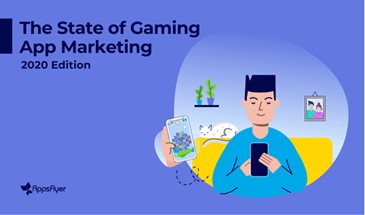- Category: July 2021 - Mobile Marketing & Analytics
 AppsFlyer’s The State of Gaming App Marketing report examines the growth of the mobile gaming industry in 2020 to provide marketers an in-depth analysis of global data-driven insights, industry trends, and growth opportunities, as well as performance benchmarks in 16 key markets.
AppsFlyer’s The State of Gaming App Marketing report examines the growth of the mobile gaming industry in 2020 to provide marketers an in-depth analysis of global data-driven insights, industry trends, and growth opportunities, as well as performance benchmarks in 16 key markets.
Games have long been the driving force of the mobile app economy. Yet, the global pandemic helped mobile gaming reach an entirely new level with a 45% jump in installs compared to 2019—40% higher than last year’s growth rate.
“It’s not a surprise that we saw a massive increase in new players trying games for the first time; in particular, Hyper Casual installs surged 90%, including a staggering 250% in the number of marketing-driven non-organic installs,” said Shani Rosenfelder, Head of Content & Mobile Insights, AppsFlyer.
“What’s significant is that gaming apps realized the opportunity to accelerate their user acquisition efforts and took full advantage of this trend while in the moment. The brands that made the reactive, nimble moves to meet heightened demand dominated the stay-at-home peaks in gaming app engagement.”
Gaming apps were able to maintain impressive revenue figures in the months that followed lockdowns worldwide by continuing to engage a large number of users who installed new games at the start of the pandemic.
AppFlyer analyzed 9.2 billion app installs for the study, identifying the following key findings:
- 25% increase in in-app purchase (IAP) revenue during COVID-19 lockdowns. The rise was driven largely by Casual games, which jumped 55% and maintained high levels of revenue. As mobile advertising faces challenges, marketers can look more toward purchases, since there’s evidence that consumers are becoming less tolerant of in-app advertising and willing to spend more in-app.
- IAP (In-App Purchase) revenue climbed. In contrast, IAA (In-App Advertising) decreased by 16% in the same timeframe.
- Hyper Casual games saw an increase of 250% for non-organic installs. The growth is attributed to marketers understanding that many new players were trying mobile gaming for the first time during the pandemic.
- Media costs rose across genres and geographies as the pandemic continued while marketing fell, causing non-organic installs to fall.
- The most significant growth factor was aggressive user acquisition (UA) early on. Large numbers of UA at the beginning of the pandemic fueled ongoing success after install decline.
“While there was robust growth in gaming app installs over the first few quarters of 2020, it’s clear that there are still areas for major growth,” said Brian Murphy, Head of Gaming, AppsFlyer. “Install growth and the return of big brands beyond gaming created a surge in media costs, demonstrating the need for marketers to implement less-expensive strategies. The most overlooked tactic in mobile gaming apps is remarketing, as re-engaging users has been a key driver of revenue in 2020.”
It’s possible that this explosive success is the “new normal” in gaming, as revenue has remained strong in 2020 while it dropped throughout 2019. However, with much uncertainty on the horizon—from the far-reaching economic effects of the pandemic, and other factors like iOS14’s changes to the App Tracking Transparency framework—it’s hard to say for certain what’s around the corner.
For more details, feel free to read the full report.
By MediaBUZZ


